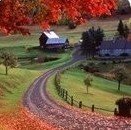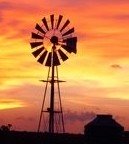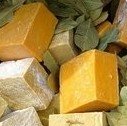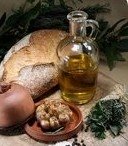Farming Memories Part 2
by K. Kraft
(ontario Canada.)
Farming Memories: The Combine Harvester
Then along came the combine. I am guessing here but I think the name combine harvester which is what the machine was originally called, was called such because it combined the actions of a binder and a threshing machine.
Anyway it was a Godsend as it would traverse a field threshing the grain and storing it in a onboard tank while processing the straw, cutting it and leaving it in a row for baling. Man that was progress!
Meanwhile the temperature is still smoking hot but by this time of year everyone is used to it so it's no big deal as long as there is plenty of water to drink.
Our family bought our combine in 1975 and it changed things so much. Realistically the combine we bought was 75% worn out when we bought it but with regular maintenance this old machine brought in our crops for 19 years. The 19th year, the year that Dad died, I drove the combine, took in the final crop and my sons rode on the side platform just like I did when Dad first bought it. Life goes on.
The next year it was sold for scrap. It was an old machine, it had done it's work and it was too big to sit on anyone's lawn.
Having a barn full of animals can keep one busy as there are chores to do morning and evening, every day 365 days a year.
In the good weather of the spring and summer it's best to get the stock out of the barn and let them graze, but in the winter the animals are inside and all the crops that were layed up in summer and fall become the sole source of food for the wintertime.
Hay, the dried grasses from the fields in the summer provide the protein and the roughage required to keep cattle with multiple stomachs busy.
Grain is a higher energy food that cattle, pigs and horses all like but it has to be ground up to allow them to digest it thoroughly.
At our farm we used a old machine called a hammer mill. Our hammer mill was driven by the old Massey tractor by a flat belt in fact the same flat belt used to run the threshing machine years before. Grain goes in one end and chopped grain comes out the other.
For years the grain was brought to the hammer mill by hand in 5 gallon pails and we bagged all the chopped grain as it was made. Then when the grain bin was put up outside the barn we used an electric powered auger to bring the grain in and we built a hopper on the barn floor that we filled with chopped grain. Oh, the wonders of modern mechanization!
There were companies that sold feed making systems at that time and I later worked on farms that had them but for simplicity and cost effectiveness you couldn't beat the hammer mill.
Farming Memories: Root Crops
"Root crops" is something that has fallen out of favor with modern agriculture. And if the truth be known probably it was pretty much history while we were still doing it.
The principle is that during the winter there is no fresh crops so anything that has taste, texture and moisture in it would be a big hit with the critters.
Turnip, mangles and carrots to a smaller degree filled this role. Turnips are something most people are familiar with. Mangles are a cousin of the turnip but are longer and actually sweeter that a turnip. Carrots are favorites of horses.
Cattle can eat turnips or mangles whole by biting pieces out of them but they spend a lot of time cornering the veggies in the trough.
The preferred method of feeding these crops are by first chipping them in a machine called, appropriately enough, a "turnip pulper". These machines still pop up at farm auctions from time to time.
They originally came with a crank so that human power would pulp those turnips but ours had a 1/4 horse power electric motor off of a different washing machine than the one on the fanning mill or maybe it was the same one.
Anyways chip a bunch of turnips or mangles and feed them by the shovelful. Anyone who has seen a cow eat hay and grain knows that cattle like hay and they love grain but they absolutely go nuts for chipped turnip or mangle.
The thing about root crops that may have lead to their demise is that there are no ways of mechanizing the small time growth of these crops. If you have ever held a handful of turnip seed you won't have held it for long as the seeds are very small, perfectly round and slide against one another quite easily.
We had a planter for turnip seeds that had been in the family for generations. My father said that his grandfather had made it. It handled those tiny seeds in a small drum that rotated driven by a string running off the wheel on the front. A trough carried the seed from the drum to just behind the front wheel and dropped it in the groove made by the wheel and a small piece of chain that hung under the device covered the seed with dirt as it trailed along the groove.
Not only do you have to plant turnip or mangle seeds by hand with the use of an ancient machine but the plants have to be weeded by hand, the tops are removed by hand to ensure maceration and they are harvested by hand.
With all the manual labour even we quit growing these old crops when we started farming more land and had less time to spend on tending "Root Crops".
Farming Memories: Farm Machinery
Here's one of my favorite parts of agriculture, it's the inanimate objects of the farm, the machinery. Tractors, combines, swathers, balers, haybines, manure spreaders, plows, cultivators, discs and so on the list is endless. There are even machines to help you look after your machines, Drill press, welder and air compressor.
These are things an operating farm needs to make repairs so that valuable time isn't spent taking equipment to a repair shop. The trick to this whole machine maintenance and repair is there needs to be someone who is handy with this whole business.
Changing oil, greasing bearings, replacing wearable parts, understanding that there are wearable parts and that one cannot operate a piece of equipment indefinitely without replacing some parts. And lastly being able to repair an acute breakdown where something is broken, bent, cracked or twisted and needs immediate attention or everything stops.
In the days of horses supplying the horsepower the same animal husbandry skills used to raise the other livestock was extended to the horses and the equipment they drew was very simple. The village blacksmith would make any repairs necessary and the farmer didn't have to spend time or energy on mechanical things.
Now and for the last many decades a working knowledge of things mechanical is essential and if a farmer has a real feel for machinery it can make a big difference to whether one can survive in the agriculture business.
We had a baler, a #10 Massey. It had baled a lot of hay and the plunger needed to reshimmed and it turned out that a 12 year old boy fits in the plunger chamber just right. Well I learned a lot about nuts and bolt that summer as my father and I disassembled the plunger and removed it, adjusted the shims and reinstalled the whole assembly. All the while that I was in the baler my Dad handed me the required tools and smoked cigarettes. When the job was done the baler worked fine and it didn't have the annoying clunking sound anymore.
That was just a warm-up for a job that came up a few years later when the combine wasn't threshing the grain off of the crops as well as it had. We removed the cover from the cylinder area which is the business part of a combine. This is where all the threshing takes place.
Anyway when the cover comes off the beater bars are bent so there is not as close contact to the crop feeding through the machine as there should be. The bolts that hold the beater bars on the cylinder are worn smooth there no wrench in captivity that will grab these bolts. We had no torch to cut them off and we didn't have the welder then to burn them off so Dad taught me how to use a cold chisel and a hammer to cut bolts.
Now this is a rough way to do mechanical work. but we got all the bolts out. When the call was made to order new beater bars it turned out the new beater bars cost more than the old combine was worth.
An executive decision was made and the chain of command informed me that if we pounded the beater bars straight on a anvil by striking them with a 10 pound sledge hammer and reattaching them to the the cylinder that it. As I was not near the top of said chain of command pound we did, bolt we did, and you know what? The old combine threashed grain just fine. Saving money while achieving acceptable results. Such is the essence of farming old school.
There was a time when farm prices were reasonable enough that city folk bought them and used them as weekend places and spent extended periods there in the summer.
We had two such families in our area and we farmed their land and helped them with improvement projects around their farms. It was a good deal for everyone as we needed more land and the rent that would normally be paid we settled by helping them with their projects and believe me they needed help with everything.
Don't get me wrong these folks were great people it was just the first time that I met folks that didn't have the same burning sense of self sufficiency that is so strong in the country folk I knew.
So when the sun started to get stronger in the late February days it was time to get the old Massey running and cut a trail to the bush to tap the trees for maple syrup. The days were getting longer and after a cold winter the heat of the sun on your face felt good.
Another year on the farm........KK.
°°°°°°°°°°°°°°°°°°°°°°°°°°°°°°°°°°°°°°°°°°°°°°°°°°
Thank you so much for sharing!
Did you find this page helpful?
Sharing is a way of saying, "Thanks!"
Follow Us and Keep Up to Date
Go back to the Home Page





